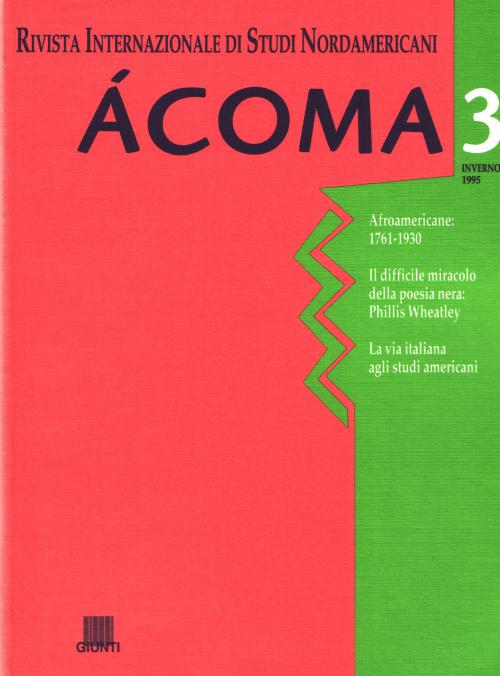Tu sei qui
Afroamericane: 1761-1930
Numero 3
Inverno 1995 - Anno II
 Afroamericane: 1761-1930
Afroamericane: 1761-1930
 Il difficile miracolo della poesia nera: Phyllis Wheatley
Il difficile miracolo della poesia nera: Phyllis Wheatley
 La via italiana agli studi americani
La via italiana agli studi americani
Afroamericane: 1761-1930
Il difficile miracolo della poesia nera in America: una sorta di sonetto per Phillis Wheatley – pag. 4
It was not natural. And she was the first. On being brought from Africa to America, Phillis Wheatley, first Black and second woman published in America, performed the difficult miracle of adopting the language and the rhetoric of her captors and yet to preserve within it the dissonance of an otherness who once existed beyond the terms of her captors' redemption. Jordan rereads Wheatley's verse in search of the traces of a genius that never could openly compose a poetry to speak of her pain, to say her grief, about her parents, her land, her people.
Resistenza, autorità e autorappresentazione nell'autobiografia delle donne nere prima della guerra civile – pag. 14
In African American women's autobiography, the metaphorical implications beneath the referential level reveal tensions both versus the systems of domination and within the group in their gender relationships, by means of narrative strategies such as irony and silence. These autobiographies «signify» and resist the external definitions of identity imposed by dominant ideologies (both of the hegemonic and African American male culture), and, while representing alternative models of women who have control over their lives and their narration, they revise the most popular modes of their time: the sentimental novel and the male slave narratives.
"I maschi non c'entrano per niente": predicatrici e profete nere nell'America dell'Ottocento – pag. 24
The historical omission of the African American female religious experience is evident if one considers the male perspective on the African American church. The essay shows the role of women as itinerant preachers in the nineteenth century against the background of the Great Revival. They base their spiritual authority on their mystical union with God and the experience of sanctification, challenging the traditional male leadership of the ecclesiastical hierarchy and institutions. Therefore they can be considered the foremothers of the contemporary African American feminist religious debate.
La tradizione invisibile: le radici ottocentesche della narrativa femminile afroamericana – pag. 29
During the past three decades, the academic invisibility of 19th century African American women writers has been challenged through systematic scholarly efforts to recover and reinterpret literary texts that had been out of print for almost a century. These works provide new insight into important issues in 19th century American literature as a whole: the popularity of the mulatto as a fictional character, the theme of passing-for-white, and the politics of representation of race and color. Amelia E. Johnson's turn-of-the-century Sunday School novels reveal the author's conscious deployment of an aesthetic of invisibility: rather than portray passing, Johnson chose to engage in passing by systematically sustaining the racial indeterminacy of her characters.
Donne nere, povertà, cittadinanza – pag. 38
Women are poorer than men in the United States, and black women poorer than white women. Yet, women's poverty has been recognized only after it beegan to affect the white population. Both racial prejudice and the disregard for different cultural attitudes (especially concerning motherhood) have made it harder for poor black women to have access to welfare and to retain their full citizenship rights.
"Got a Mind to Ramble": in viaggio con Jessie Fauset – pag. 50
The traditional division between the mobility of men and the domesticity/domestication of women is to be found also within the African-American tradition, including the "Harlem Renaissance". The travel writings (essays, articles, letters) of Jessie Fauset are an open criticism of this attitude, and a stringent attack on the myths of colonialism and "superior races". At the same time, Fauset also struggles with the ambivalence of her stance as traveler and "tourist".
Testo a fronte
Tradurre Whitman. Leaves of Grass - Foglie d'erba – pag. 64
Intervista
La via italiana agli studi americani. Intervista con Agostino Lombardo – pag. 70
Italian scholars have always been very much aware of the need to connect American literature to its social and historical background, even more closely than other literatures. Thus, noncanonical and minority strands of American literature have historically been part of the Italian approach. On the other hand, Lombardo reaffirms the need to keep literature in its central place, rather than losing its specificity in less focused disciplinary approaches.
Città d'America
Cicero, Illinois: capitali e criminali all'ombra di Chicago (1857-1930) – pag. 75
The essay retraces the main phases in the history of Cicero, on the western border of Chicago, from its founding in 1857 to the 1930s. The author focuses his attention first on the social life of the Italian immigrants who populated the Grant Works district of the growing town, then analyses the coincidences between the industrial development - centered on the famous Western Electric's «Hawthorne Plant» - and the reign of Al Capone. Harmon's thesis is that Capone followed the corporate model provided by American big business to organize his crime syndicate.
Saggi
Modi di produzione: Hemingway e Hawks – pag. 84
The essay deals with two main issues: how far a movie can diverge from the novel it is ostensibly based upon, and how different are the creative processes in which the narrator and the film-maker are involved in. While writing a novel is a lonely affair, directing a movie is the final stage in long, collective effort. Howard Hawks's film To Have and Have Not was enourmously disrespectful of Ernest Hemingway's novel by the same title. But it also came to be that different because of the many people, interests, influences that play a role in the creation of a movie at one moment or another.

